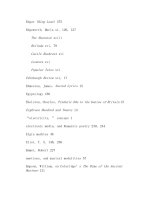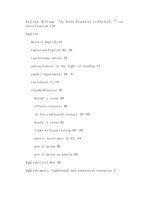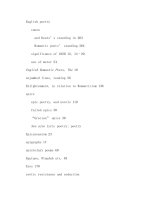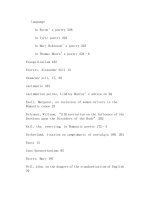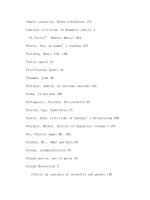The cambridge companion to british roman 33
Bạn đang xem bản rút gọn của tài liệu. Xem và tải ngay bản đầy đủ của tài liệu tại đây (38.53 KB, 1 trang )
The living pantheon of poets in 1820
1780–1830 (1996), we have in turn lost sight of the “minor,” popular male
British writers of the day.1
Our focus on a group of writers whom we have united under the banner of “Romanticism” – whether it involves only a few male poets or a
broader gathering including women – can seem odd to those interested in
other eras. While most periods are named for relatively neutral language
features (Anglo-Saxon), rulers (Elizabeth or Victoria), or temporal aspects
(modern or postmodern), the Romantic period is named for a particular
trend in poetry, retrospectively applied. It is as if we would call the period
of early modern English literature “metaphysical,” using Dr. Johnson’s later
term for a particular group of poets to define all the work of that era. While
we now conceive of the poetry between roughly 1789 and 1832 as part of
a unified “Romanticism,” at the time the poets we identify with Romanticism were grouped in a series of often opposing schools: for example, the
Bluestocking circle of artistic and intellectual women who gathered in the
second half of the eighteenth century; the Della Cruscans, who followed
their leader Robert Merry in offering highly wrought and politically controversial poetry; the Lake School of Wordsworth, Coleridge, and Southey; the
Cockney School of London intellectuals and artists, including Keats, Shelley,
and Hazlitt, that centered on Leigh Hunt; or the Satanic School, Southey’s
derogatory name for the partnership of Byron and Shelley. Of course, Blake,
so central to our sense of Romanticism now, stood apart not only from these
schools but from the literary scene as a whole, though his engagement with
the literature of the day is seen, for example, in his responses to Wordsworth
and Byron. Not that “Romanticism” should be discarded as a period term:
it describes a body of experimental work in the late eighteenth and early
nineteenth centuries that points to larger trends in poetry beyond its confines. “Romanticism” enables us to gather together a group of poets who
responded to a common moment of massive cultural, social, and political
change with varying attempts to remake poetry and re-vision their world. As
poetic innovators seeking to remake the world through their art, they both
opened up the forms of poetry – think of Wordsworth’s exploration of “lyrical ballads,” Blake’s turn to fourteeners or his dissent from the very means of
literary production, the work on the sonnet of Charlotte Smith, Wordsworth,
and Keats, or Hunt’s assault upon the heroic couplet that would influence
Shelley and Keats – and opened poetry upon the world, as they sought an art
that could, like Keats’s god of poetry, Apollo, in “Hyperion,” “die into life,”
that is, leave behind the confines of art to build or remake the human community. While Wordsworth and Blake, Scott and Shelley, Byron and Hemans
engaged in different kinds of aesthetic experiments for differing purposes,
they all sought to make poetry new in ways that both impressed and puzzled
11
Cambridge Collections Online © Cambridge University Press, 2008

